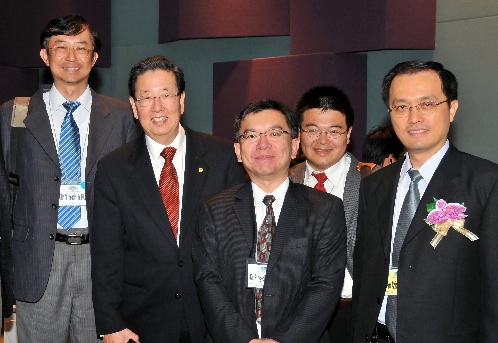Recipient of the Taiwan Fellows Research Scholarship
 In September 2010, I began a Post-Doctoral Research Fellowship at the Musculoskeletal Research Center (MSRC), in the Department of Bioengineering at the University of Pittsburgh, directed by Dr. Savio L-Y. Woo. I am an Orthopaedics Residency Fellow from the Orthopaedics Residency Program at the University of Perugia, Italy, directed by Professor Giuliano Cerulli. In the summer of 2011, I was honored to receive the Taiwan Fellows Research Scholarship that was donated to ASIAM Institute by Drs. Chih-Hwa Chen, Wei-Hsiu Hsu, Yin-Chih Fu and Ping-Cheng Liu. During my fellowship at the MSRC, my research was focused primarily on the development of magnesium (Mg)-based interference screws for anterior cruciate ligament (ACL) reconstruction as a novel class of bio-absorbable material. Screws and suture anchors are utilized broadly and regularly as fixation devices in orthopaedics. Screws are also used in repair or reconstruction procedures following injury to soft tissues, especially ligaments and tendons in the knee, shoulder, wrist and ankle joints.
In September 2010, I began a Post-Doctoral Research Fellowship at the Musculoskeletal Research Center (MSRC), in the Department of Bioengineering at the University of Pittsburgh, directed by Dr. Savio L-Y. Woo. I am an Orthopaedics Residency Fellow from the Orthopaedics Residency Program at the University of Perugia, Italy, directed by Professor Giuliano Cerulli. In the summer of 2011, I was honored to receive the Taiwan Fellows Research Scholarship that was donated to ASIAM Institute by Drs. Chih-Hwa Chen, Wei-Hsiu Hsu, Yin-Chih Fu and Ping-Cheng Liu. During my fellowship at the MSRC, my research was focused primarily on the development of magnesium (Mg)-based interference screws for anterior cruciate ligament (ACL) reconstruction as a novel class of bio-absorbable material. Screws and suture anchors are utilized broadly and regularly as fixation devices in orthopaedics. Screws are also used in repair or reconstruction procedures following injury to soft tissues, especially ligaments and tendons in the knee, shoulder, wrist and ankle joints.
Together with Mr. Kwang Kim, Ms. Katie Farraro, Mr. Hunter Eason and Ms. Aimee Pickering, we started to develop a novel class of biodegradable metallic screws based on Mg alloys. The devices made from these materials can have the desirable properties to effectively address the shortfalls of existing metallic and polymeric screws. The successful development of an ideal interference screw should change the clinical paradigm to significantly impact clinical practice. In the case of ACL reconstruction, the increased osteoinduction by Mg-based screws could reduce tunnel widening by stimulating the overall healing of the graft within the tunnel for an improved long-term outcome. Having all the advantages of metallic and polymeric materials, screws made from Mg alloys could also reduce the chance of implant breakage during implantation, have controllable rates of degradation, and improve osteo-integration in vivo, while having only minimal MRI interference following their implantation. Using literature for reference, a surgical technique for in-vitro as well as in-vivo surgeries in a goat ACL reconstruction model, was established. By the end of summer, I performed more than fifteen in-vivo surgeries to test the effectiveness of the Mg-based screws compared with the commercially available polymer interference screws. This was the most exciting part of my study. During my experience at the MSRC, I contributed to the development of a second generation Mg interference screw and hopefully, a Mg screw for the human clinical practice for the future. Certainly more has to be done, but it was my first opportunity to conduct and understand how to do research in my area of interest. It would not have been possible without the support of Dr. Woo, Professor Cerulli, The Taiwan Fellows Research Scholarship and my Family. Thank you!

